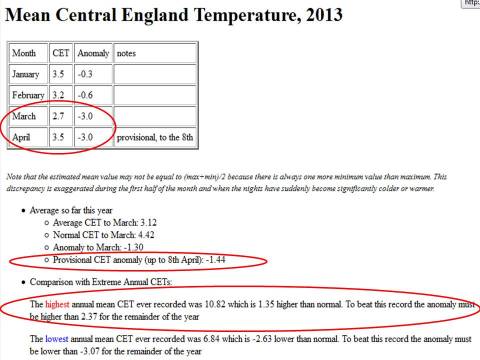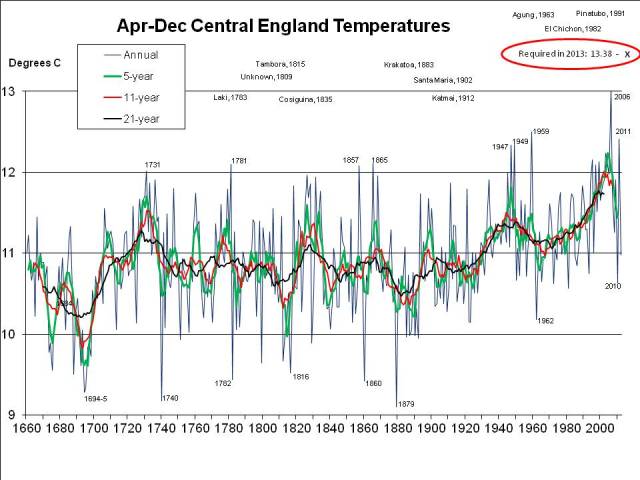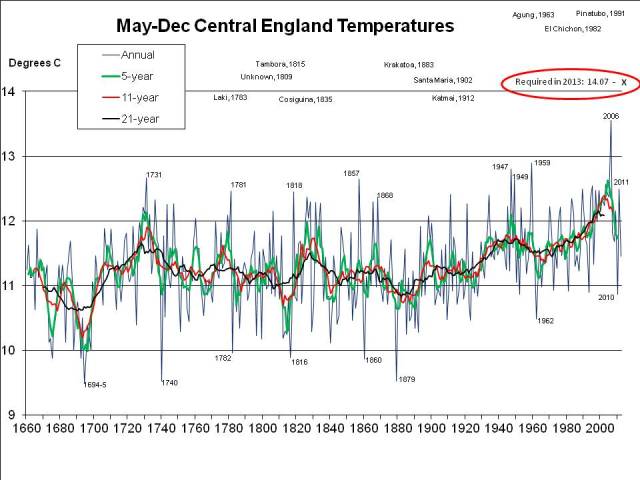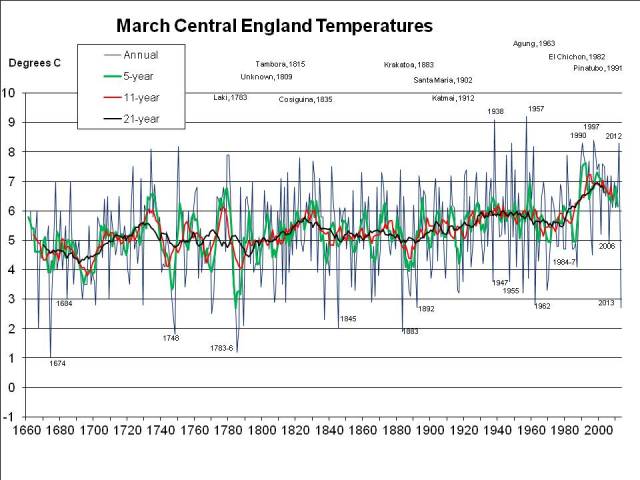Blossom is appearing and buds are opening. The front garden magnolias of West London are coming into flower. The weather is turning milder in the UK. Spring is here at last.
So perhaps I’ll be coming to the end of posts on the subject of unusual weather for a while. Until there’s some more!
We’ve seen that March 2013 was, with 1892, the equal coldest in the CET since 1883, which is particularly significant given the generally warmer Marches in recent decades.
The first quarter of 2013 was the coldest since 1987, and the cold has now continued into April. This is where we now are, according to the Met Office:
So far this year it’s been 1.44C colder than the average over 1961-90, which is the basis for CET “anomalies” here.
The rest of the year would have to be 2.37C warmer than usual, on average, for 2013 to be the warmest in the record.
Is it possible for 2013 to still be the warmest year in the CET? I’m saying no – or, to be more measured, it’s extremely unlikely.
Last year, it was July 13th before I felt able to make a similar statement.
But now I’ve realised that I can simply plot a graph of the later parts of previous years and compare them to the required mean temperature in 2013.
Here’s the graph of mean CET for the last 9 months of the year:
Perhaps the most notable feature is that the last 9 months of 2006, at 13C were a whole 0.5C warmer than the last 9 months of the next warmest year, 1959, at 12.5C!
It’s easy enough to calculate that for 2013 to be the warmest year in the CET, the mean temperature for the last 9 months of the year would have to be 13.38C.
To be warmer than the warmest year in the CET, also 2006, the last 9 months of 2013 would need to be 0.38C warmer than the last 9 months of 2006. That’s a big ask.
But let’s look a little more carefully at 1959. The last 9 months of 2009 were about 1.4C warmer than the prevailing mean temperatures at the time, given by the 11 year (red line) and 21 year (black line) running means. The last 9 months of 2006 were “only” about 1.1 or 1.2C warmer than an average year at that time.
If 2013 were 1.4C warmer than the running means in previous years (obviously we can only determine the running means centred on 2013 with hindsight) then it would not be far off the warmest year in the CET.
No other year in the entire CET spikes above the average as much as 1959, so we have to suppose the last 9 months of that year were “freak” – say a once in 400 year event – and extremely unlikely to be repeated.
So on this basis it seems 2013 is extremely unlikely to be the warmest in the CET.
Now we have a bit of data for April we can also carry out a similar exercise for the last 8 months of the year.
The Met Office notes (see the screen-grab, above) that the first 8 days of April 2013 were on average 3C cooler than normal in the CET (“normal” with respect to the CET is always the 1961-90 average). If we call those 8 days a quarter of the month, the rest of the month needs to be 1C warmer than usual for April as a whole to be average. Let’s be conservative, though, and assumes that happens.
It’s easy enough now to calculate that for 2013 to be the warmest year in the CET, the mean temperature for the last 8 months of the year would have to be 14.07C, assuming the April temperature ends up as the 1961-90 average.
On this basis, we can then compare the last 8 months of previous years in the CET with what’s required for this year to be the warmest on record:
Here 2006 seems more exceptional, and 1959 not quite such an outlier. (April is not now included: in 1959 the month was warm at 9.4C whereas in 2006 it was warmer than average at 8.6C, but not unusual).
Clearly, the spike above the running means would have to be a lot higher than ever before for 2013 to be the warmest year in the CET. Those 8 cold days seem to have made all the difference to the likelihood of 2013 breaking the record.
That’s it for now – though if April is particularly cold this year, a comparison of March and April with those months in previous years will be in order. The plot-spoiler is that 1917 was the standout year in the 20th century for the two months combined.



